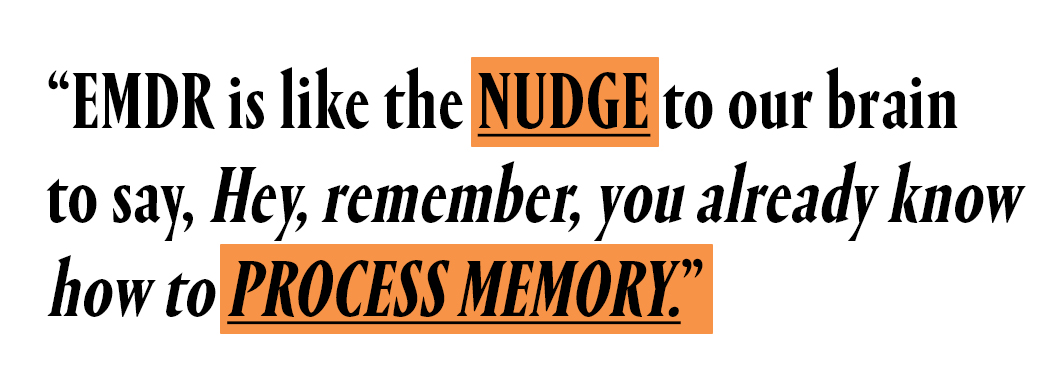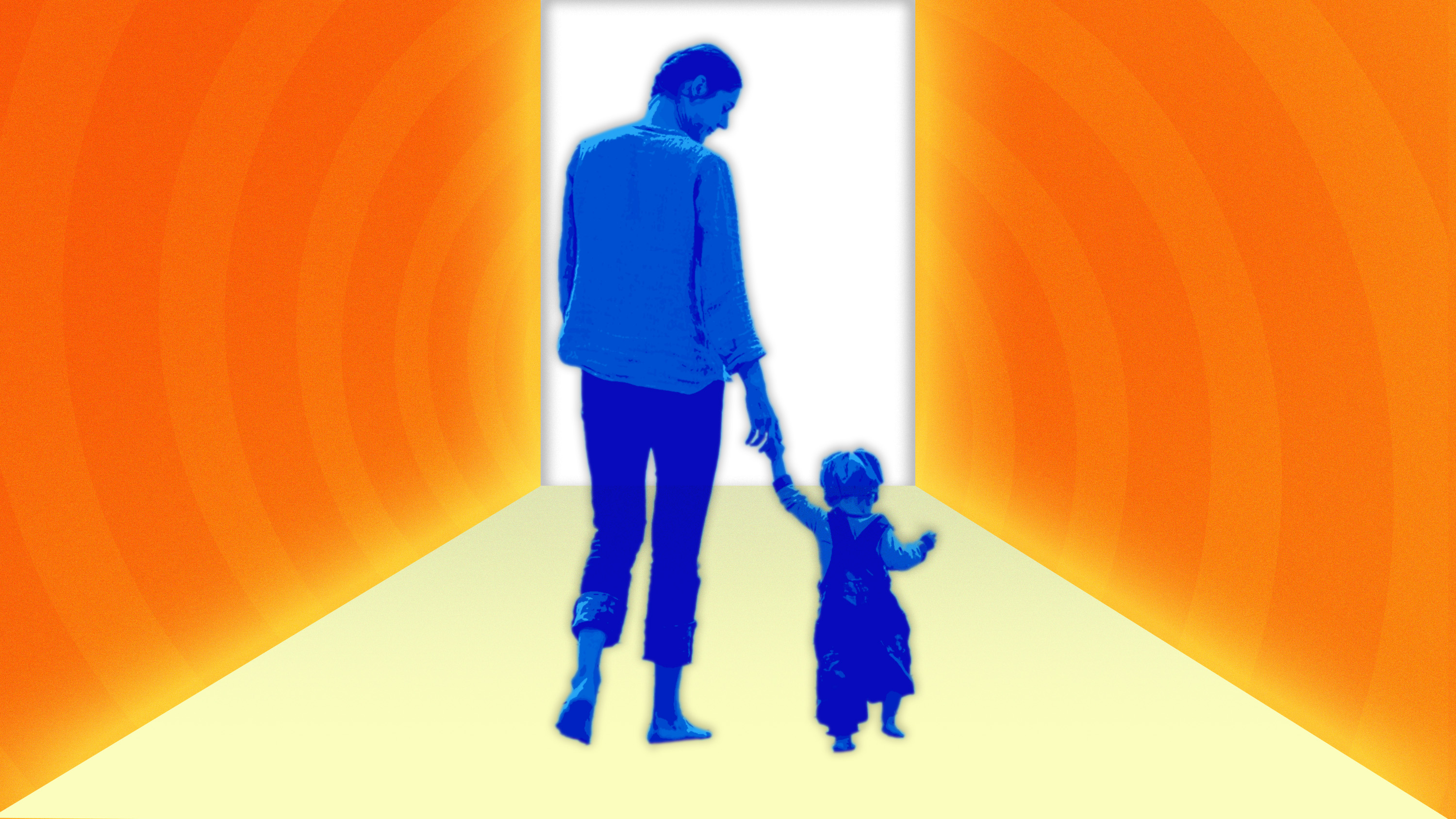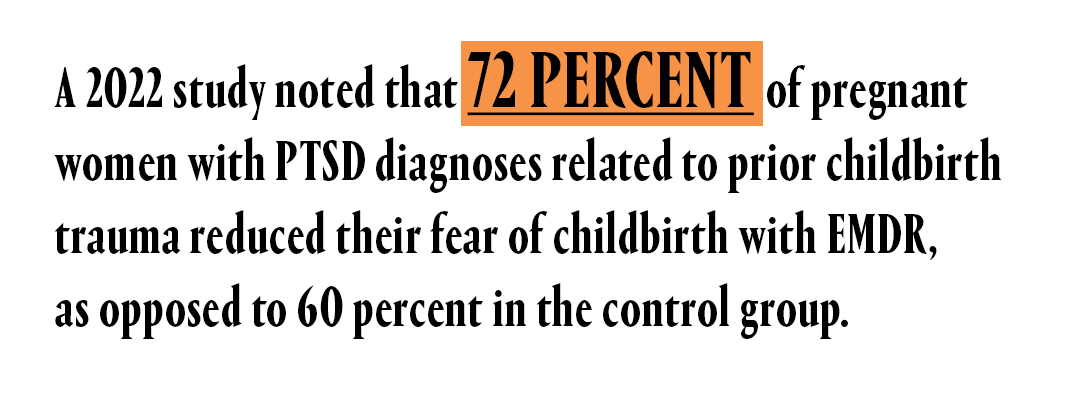Could EMDR Be the Key to Treating Reproductive Health Trauma?
The lesser-known mental health treatment is helping women deal with postpartum depression, anxiety, and other perinatal mood disorders.

When her water broke in January 2015, Rocio (who is using her middle name to protect her privacy) went to the hospital. Two and a half days later, she was still in labor.
Oh my God, when is she going to be done? Rocio remembers the nurses saying to each other, as if she couldn’t hear them. Probably she’s too overweight. She should have eaten less in the pregnancy.
When it came time to push, the baby still wouldn’t come out. In a phone interview, years later, Rocio can still recall how nervous she felt as she sensed the nurses’ frustrations building. “I just really felt that pressure from everyone around me, like I wasn’t doing it right,” says Rocio. She felt like a failure—and powerless, like she wasn’t in control of her own body. She’d expected childbirth to be tough but joyful, and she found herself questioning whether her experience was normal.
While pushing, Rocio started hemorrhaging and her baby’s heart rate dropped significantly. Rocio, who was 33 at the time, recalls hearing the doctor matter-of-factly tell her husband, “We can either save her or the baby. We’ll try our best.” As Rocio was rushed to an emergency C-section, she prayed and told her husband, “If you have to choose, please choose the baby.”
Both Rocio and her son were okay. But in the weeks that followed his birth, she was riddled with intrusive thoughts: Is he really healthy or did something happen during my labor or birth that affected him and I just don’t know it yet? I need to be with him at all times to keep him safe. I need to control everything. She became hypervigilant about who held him. Besides her husband, she trusted nobody to be with her newborn without her. Even though she was exhausted, she had difficulty sleeping. She didn’t leave her house for a month.
Three months postpartum, her anxiety increased. Rocio, who works in the mental health field in California, could tell something was amiss. But that she continued to feel worse, not better, confused her. She was well past the six-week postpartum mark—that was supposed to be the worst emotional part.
She met with multiple therapists but didn’t feel like they understood her and decided to take a break from her search. Instead, Rocio read about other mothers’ experiences on Facebook and learned about perinatal mood and anxiety disorders, commonly known as PMADs. One in five new mothers experience a PMAD, which can include depression, anxiety, OCD, PTSD, bipolar disorder, or psychosis that can occur in pregnancy or in the first 12 months after childbirth. (One 2010 study found one in ten new dads can experience PMADs as well.) People of color are disproportionately impacted by PMADs, while simultaneously often being the ones who are underscreened by providers and not offered the same resources for treatment that white women are.
Get exclusive access to fashion and beauty trends, hot-off-the-press celebrity news, and more.
“I didn’t know that birth could be traumatic. I didn’t know that postpartum anxiety was a thing," says Rocio. "I’d always heard about postpartum depression, but I wasn’t weeping. I didn’t think about self-harm.”
Eight months after her baby was born, Rocio—finally armed with the knowledge of who she was looking for—found a perinatal mental health specialist who was also a woman of color. With a therapist who had expertise in PMADs, Rocio began to replace her self-doubt and her feeling that her son "deserved a better mother who could actually handle tough situations” with the beliefs: I did my best, my body did my best, I am a good enough mother, my baby is safe with me and can be safe with other people.

Rocio’s therapist uses a lesser-known but highly effective treatment for PMADs and other kinds of reproductive health trauma: EMDR, which stands for eye movement desensitization and reprocessing. Discovered in 1987, EMDR has gained attention in the past decade due to its appearance in shows like Grey’s Anatomy and The Affair. Prince Harry, Evan Rachel Wood, and Sandra Bullock have all spoken about their experience with the treatment, which is often used to target different types of trauma.
EMDR uses “bilateral stimulation” to affect the way the brain processes information. This can be achieved by having your eyes follow a lightbar or hand back and forth. It can also work by holding alternating vibrating buzzers in your hand or tapping yourself on opposite sides of your body. EMDR therapists acknowledge that it might sound odd at first, but they maintain there’s neuroscience backing it up.
Bethany Warren, a certified perinatal mental health professional who’s been working for 25 years in perinatal mental health and trauma field and who co-wrote The Pregnancy and Postpartum Mood Workbook, says she thinks that the “eye movement" in the name makes people “think it’s a trick. ‘Oh, I’m just going to move my eyes back and forth and all is going to be well.’ That’s not true. What’s happening is truly more complex than that.”

According to Warren, the process mimics what happens in REM sleep, when our eyes are moving and our brains are processing information between hemispheres. Information is going from our prefrontal cortex, which is responsible for logic, data, reasoning and impulse control to our limbic system, which is more about emotions and body sensations. “Something will happen that’s so distressing that the process gets disrupted, halted," says Warren. "Memory gets stuck in a feeling state where it’s reactivated and triggered. EMDR is like the nudge to our brain to say, Hey, remember, you already know how to process memory.”
Mara Stein, Psy.D, a clinical psychologist and specialist in perinatal mental health and trauma-focused care, was initially skeptical of EMDR, brushing it off as ridiculous. But then she started to learn more about the neurobiology behind it. “I started to use it and I was blown away,” says Dr. Stein. “People didn’t get stuck anymore.”
Dr. Stein says that when there's a disconnect between your body's experience and the thinking part of you, the solution can be talk therapy, but in some circumstances, that's not enough. EMDR, on the other hand, is specifically about rebuilding those connections in the brain. “Our nervous systems know how to do this, they know how to metabolize hard, scary, overwhelming things,” she says. “Sometimes our body’s natural capacity for healing gets blocked because that’s what can happen with trauma. EMDR gives the healing parts of the nervous system access to what’s been stuck and allows for integration to happen.”

As EMDR has become more popular for use with general trauma, so too has awareness about reproductive mental health. In the past five years there have been multiple studies looking specifically into PMADs and how dangerous these disorders can be. PMADs contribute to 50 percent higher rates of severe maternal morbidity compared to people without mental health disorders. During the pandemic, studies found the rates for PMADs increased two to three times. A new study the CDC just released reported a significant jump in maternal mortality rates, with 1,205 people dying of maternal causes in 2021, a 40 percent increase from the previous year. Pregnant people of color, especially Black Americans, were disproportionately affected. Many of the therapists that spoke with Marie Claire said they are concerned that, with the recent Dobbs decision, forced pregnancies will only increase the mental health risk for pregnant people.
In addition to treatment for people who are suffering from PMADs, EMDR may be used when a pregnant person is trying to decrease a fear of childbirth by resolving a previous reproductive trauma, whether that’s birth trauma, pregnancy loss, or infertility. A study conducted in 2016 saw reduced childbirth anxiety for pregnant women following stillbirth after using EMDR. A 2022 study noted that 72 percent of pregnant women with PTSD diagnoses related to prior childbirth trauma reduced their fear of childbirth with EMDR, as opposed to 60 percent in the control group.
Warren also sees it being effective with people who have suffered reproductive trauma and are not pregnant, as well as people who have not suffered reproductive trauma yet, but have “wounds from childhood” that are being triggered when preparing to become a parent themselves.
Lauren Citro had been struggling with infertility for six-and-a-half years when she first heard of EMDR from a friend who used the treatment following a miscarriage. Citro says she’d thought of EMDR as something military veterans use, but after years of failed IVF, multiple early pregnancy losses, and endometrial biopsies, Citro felt anxious and depressed and decided to try it out. “I went in thinking, ‘Okay, two or three sessions max and I’ll be good to go! Just EMDR me and I’ll be fixed!’” The healing process took much longer, especially because Citro, a 35-year-old education specialist at a family-building platform, was still in fertility treatments when she started. “As my therapist says, ‘It’s hard to heal trauma when you’re actively being traumatized.’”
In 2020, Citro did her first “reprocessing session,” which occurs after the therapist establishes what “triggers” the patient will target. It was virtual, and she sat in front of her computer screen with her elbows resting on a pillow in her lap. She would alternate making a fist with each hand, training her eyes to move back and forth, looking at each hand while squeezing it. (“This took some practice,” Citro admits.)

“I thought that we would start with a traumatic memory from one of my [pregnancy] losses and we started with phrases that would trigger me. One of my phrases was ‘I am bad,’” says Citro. Her therapist asked her to recall her first memory of having that feeling. “I remembered a memory that I hadn’t thought about in probably 25 years,” she says. “I was all of a sudden in first grade again.” Citro continued squeezing her hands alternately for 30 seconds, crying, as her therapist told her to just let her brain go where it wanted to go. “It felt like I was watching myself in a movie. I was jumping from memory to memory.” While the memories didn’t initially seem related, by the end of the session Citro realized there were ties between all of them.
“Anytime something bad happens, I think it’s because of something I did that’s bad,” says Citro. Throughout her subsequent sessions she worked on replacing that belief with a positive one. In some sessions, she’d imagine herself going through an IVF procedure ahead of time; she likened it to a downhill skier mentally moving through the course before a competition. “I thought about what I wanted to feel and what I wanted the message of the day to be,” says Citro. She was taught to, in between sessions, put her negative feelings in an imagined container, and to picture herself in a safe place when she was getting overwhelmed.
When Citro eventually got pregnant, she continued EMDR. “It didn’t make every single fear disappear, but it did turn down the temperature on them,” she says. She currently has an infant and says that while childbirth was “really intense” and “eventful” she doesn’t feel trauma associated with it. “Anytime I think about it I’m like, ‘I’m a badass and I deserve a trophy and I got one and it’s my baby.’”
As Citro experienced, EMDR can be “comprehensive,” as both Warren and Dr. Stein put it, because it helps heal old wounds that were unresolved as well as present-day issues that are triggering and impactful. Warren stressed how crucial it was that people with PMADs get assistance from therapists with some kind of training in perinatal mental health, specifically. “Treating OCD in the perinatal period is very different from how you would treat OCD in a man, or even a non-mother female client,” says Warren. “When women are becoming mothers, it just reopens all sorts of stuff from their own childhood.” She adds, “Mental health preparation needs to be just as vital as childbirth prep classes.”
When Caitlin Zaback first did a reprocessing session five years ago she thought, “Why am I working on this thing from when I was four years old? If we start with when I’m four, how are we going to get to the current [issue]?”
But like Citro, Zaback quickly realized her core beliefs were all related. Zaback, a 39-year-old attorney from San Diego, developed postpartum anxiety following a traumatic emergency C-section and was hypervigilant with her son after he was born. “I was worried about everything,” she remembers. “That he wasn’t going to sleep, that nobody was going to sleep, that he wasn’t going to be healthy because he wasn’t sleeping.” Her therapy helped temper her anxiety and she relied on it significantly when preparing for her second baby, who was born in March 2020.
“My kids like to come into the world really dramatically,” says Zaback, laughing on the phone. “No peaceful births for me.” But despite the events surrounding her daughter’s birth—and even the fact that she was born just as the pandemic was starting—Zaback didn’t feel traumatized by her second birth, which she attributes to her therapy.
One of the downsides to EMDR: Cost. Nayeli Corona-Zitney is a licensed clinical social worker and perinatal mental health psychotherapist who sees clients in private practice and also facilitates perinatal support groups and training. According to her, EMDR is expensive, and while some insurances do cover it, anyone not covered by insurance could pay out of pocket an average of $100 to $200 per session. Some therapists in private practices do accept sliding scale fees to try and increase accessibility.
Corona-Zitney works with many immigrant women and says it is important to note that undocumented Latina women face PTSD at nearly four times the national rate. Corona-Zitney, an immigrant from Mexico herself, said this puts them at an increased risk factor for PMADs.
EMDR has been invaluable to her practice. It helps get to the root of an issue, and can be especially impactful when dealing with migration trauma or intergenerational trauma or racism. Essentially, a woman of color who has a traumatic experience in her reproductive journey can relate that to other experiences in her past where she has felt coerced, overpowered, or not believed, Corona-Zitney explains. “You start off at one point and end up in another area of her life that can be reprocessed and desensitized and can bring a collective healing over a thing she didn’t even know existed.”
For Rocio, the collective healing that EMDR therapy brought her, helped her feel empowered when she gave birth to her second child. “It was a very different, positive, healing experience,” says Rocio. “I knew I wanted to feel heard and seen and supported and not dismissed like the first time. That was the final closure and confirmation that I’m in a good place.”
Lorena O'Neil is a reporter and photojournalist based in New Orleans covering reproductive health, gender, culture, and politics. She has written for The Atlantic, Elle, Esquire, Jezebel, and NPR.
